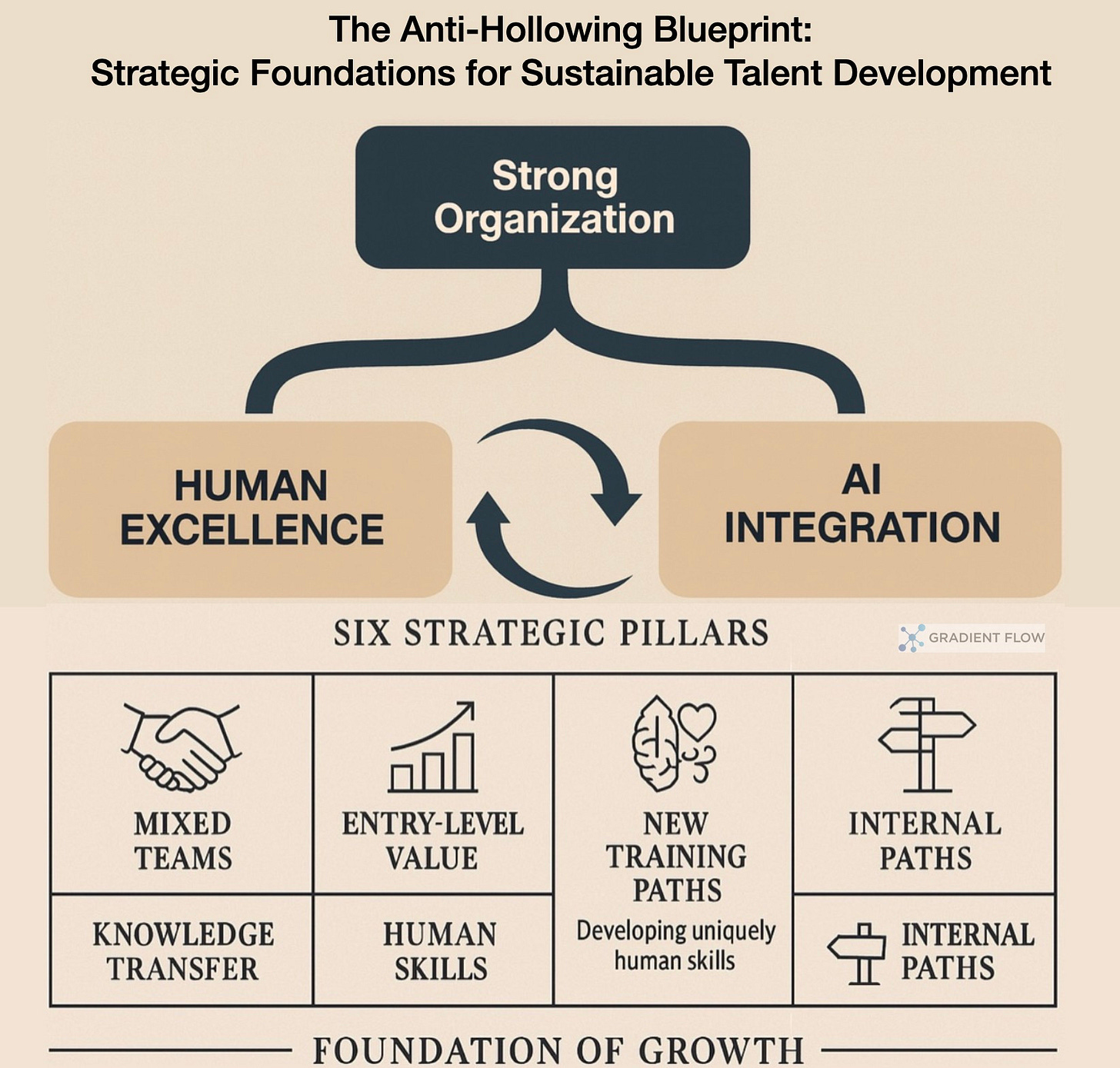The "AI Doom Loop" is here
The Great Hollowing-Out: AI and the Junior Role Crisis
I’m coming across more articles about the looming impact of AI on jobs, and many paint a particularly dire picture for recent college graduates and young professionals. The data, unfortunately, reinforces this narrative. For the first time in over 45 years of recorded data, the unemployment rate among recent college graduates has inverted, now standing between 5.8% and 6.6% — significantly higher than the national average of around 4%. This isn't just a statistical blip; it's a structural shift affecting even elite institutions. Between 2021 and 2024, the share of Stanford Business School graduates with a job three months after graduation fell from 90% to 80%.
The anecdotes behind these metrics are just as telling. Entry-level job postings in the U.S. have fallen more than 20% below pre-pandemic levels, while senior roles have actually increased. The job search has become a high-volume, low-response ordeal. One computer science graduate documented applying to over 5,000 tech positions, which resulted in only 13 interviews and zero offers. Graduates from top-tier schools like Cornell and Boston College, armed with strong academic records and prestigious internships, report sending out 150 to 200 applications with minimal success, often receiving automated rejections within minutes. The data indicates that this is a structural transformation of the entry-level market, not a temporary fluctuation.
The Missing First Rung: A Junior Role Crisis
The signs that AI is reshaping the employment market for young professionals are becoming too clear to ignore. The impact is particularly acute in sectors that were once seen as reliable paths to a stable career. Tech companies, for instance, have cut the share of entry-level positions in their hiring by half since 2019. Today, recent graduates account for just 7% of their new hires. This trend is driven by a fundamental change in corporate philosophy, crystallized by Shopify’s CEO in a directive to his company: "No more new hires if AI can do the job." This isn't just happening in tech; major financial institutions like DBS Group are planning to eliminate thousands of positions through AI adoption.
This corporate transformation has created a difficult paradox for job seekers. The application process has devolved into what some call an "AI doom loop," where candidates use AI to mass-apply and companies use AI to mass-reject, often without any human review. UK employers now receive an average of 140 applications for every graduate position, a 59% surge in just one year. At the same time, employers are raising their standards. A recent Deloitte survey found that 61% of employers have increased experience requirements for entry-level roles over the last three years, creating an impossible catch-22: young professionals cannot get a job without experience, but the very roles that once provided that experience are disappearing.
Perhaps the most concerning development is the automation of foundational "grunt work" that has long served as the training ground for entire professions. Law firms report a 40% reduction in the document analysis work traditionally assigned to first-year associates. Investment banks acknowledge that because AI now handles basic data collection and visualization, they are "reducing entry-level headcount." This automates portions of the grueling analyst work — the kind of all-night pitch book sessions detailed in Karen Ho's Liquidated, which I reviewed years ago — that once served as a brutal but essential rite of passage. But that rite of passage was the learning mechanism, and as it's automated away, companies are increasingly expecting senior-level judgment from day-one employees. Of course, AI is not the only factor cited in the current market weakness (see this graphic).
Cultivating Future Leaders When Junior Roles Vanish
As companies automate entry-level tasks, they face a critical long-term risk: what my friend Evangelos Simoudis calls "hollowing out" their talent pipeline, creating a leadership vacuum in five to ten years. If there are fewer junior employees moving up the ranks, where will future partners, executives, and senior managers come from? Forward-thinking organizations are beginning to address this challenge not by halting automation, but by fundamentally redesigning their approach to talent development. This involves a strategic shift from pure role elimination to workforce transformation. DBS Group, for example, plans to cut 4,000 jobs but is simultaneously creating 1,000 new AI-specialist positions, focusing on redeployment.
The most effective strategies treat AI as a tool for augmentation, not just automation. Instead of replacing junior staff, companies like Accenture are deploying AI "copilots" that allow them to tackle more complex assignments, accelerating their development. McKinsey has deployed thousands of AI agents to handle routine analytical tasks, but it retains junior employees to oversee, verify, and direct these systems. This approach reframes the entry-level role from a "creator" of first drafts to a "verifier" and "orchestrator" of AI-generated work, preserving a crucial rung on the corporate ladder.
To compensate for the loss of learning through routine tasks, some companies are creating new, intensive training models. The pipeline operator Williams, for instance, established a two-day onboarding program where senior executives directly teach business fundamentals to new hires. This deliberate knowledge transfer ensures the "company way" is passed down even when apprentices can no longer learn it by osmosis. These initiatives show a commitment to maintaining a sustainable pipeline of talent, recognizing that a corporate structure with a missing base is ultimately unstable.
Educational partnerships are also critical. OpenAI's collaboration with California State University and Microsoft's $4 billion investment in AI training ensure graduates arrive workforce-ready. Forward-thinking firms are reimagining internships to focus on AI-augmented work, teaching students to critically evaluate AI outputs while identifying errors and biases. By maintaining these developmental opportunities, companies avoid creating a leadership vacuum that could cripple them in five to ten years.
Partnership, Not Replacement: An Augmented Future
In a recent conversation I had with Jackie Brosamer and Brad Axen of Block, they offered a compelling vision for how AI is changing software engineering. Brad explained that new engineers are onboarded with AI coding tools from day one, allowing them to navigate complex codebases without needing a mentor for every basic question. Jackie noted that this levels the playing field. "We're all beginners here," she said, explaining that because best practices for using these new tools are still emerging, junior engineers are excited to be on the forefront alongside everyone else. Brad envisions a future where 90% of code is AI-generated, with engineers providing the final, crucial 10% of quality control, integration, and strategic oversight.
As foundation models and the tools to customize them for specific workflows continue to improve, this "augmentation" model offers a path forward. The companies that thrive will not be those that simply cut the most jobs, but those that thoughtfully integrate AI while investing in their human workforce. To avoid a hollowed-out future, leaders should focus on:
Preserving Mixed-Experience Teams: Resist the urge to eliminate all junior positions. Research from companies like BMW has found that teams with a mix of novices and experts consistently outperform homogeneous groups, as fresh perspectives from newcomers complement the wisdom of experienced veterans.
Redefining the Entry-Level Value Proposition: Rebrand the junior role to attract talent by focusing on higher-value work. The investment firm Carlyle now "pitches to recruits that they won't perform grunt work," instead reframing the job around verifying and challenging AI-generated analysis.
Reimagining Apprenticeships: Actively design new training models and "gateway" roles that provide structured learning paths. The goal is to ensure that even as AI handles routine work, the next generation of leaders has a clear and viable path to develop the skills and institutional knowledge needed to succeed.
Implementing Structured and Intentional Knowledge Transfer: Since new hires can no longer learn by observing routine tasks ("learning by osmosis"), companies must create deliberate systems for mentorship. Some firms are being "far more intentional" about mentoring, using structured debriefs and simulations to actively develop both technical and soft skills in new hires.
Developing Uniquely Human Skills: Prioritize training in critical thinking, complex problem-solving, creativity, and emotional intelligence — capabilities that AI cannot replicate. Companies are already reporting they are twice as likely to prioritize these soft skills in hiring.
Creating Internal Mobility Pathways: Instead of laying off employees whose roles are automated, build robust programs to reskill and redeploy them. One UK bank successfully retrained 60 at-risk branch employees into data analysts and software developers, achieving 100% redeployment.
Data Exchange Podcast
Ben Lorica edits the Gradient Flow newsletter and hosts the Data Exchange podcast. He helps organize the AI Conference, the AI Agent Conference, the Applied AI Summit, while also serving as the Strategic Content Chair for AI at the Linux Foundation. You can follow him on Linkedin, X, Mastodon, Reddit, Bluesky, YouTube, or TikTok. This newsletter is produced by Gradient Flow.






